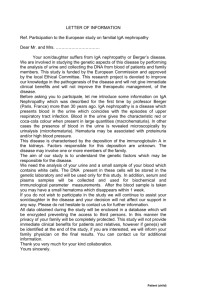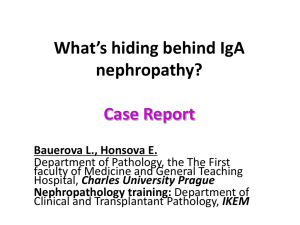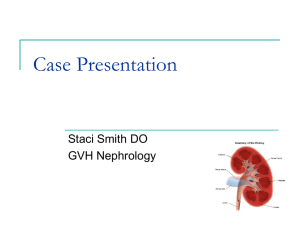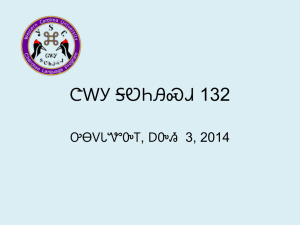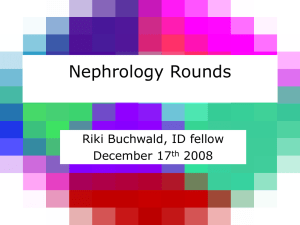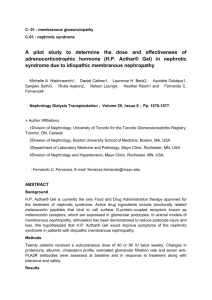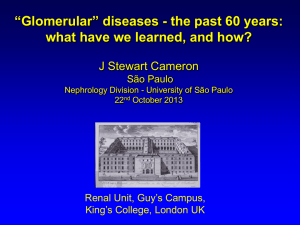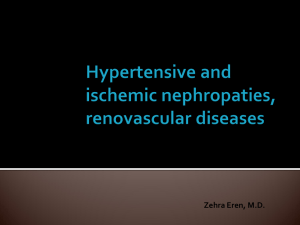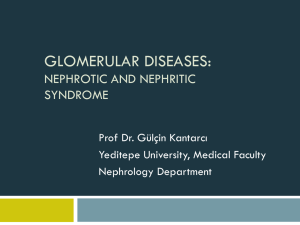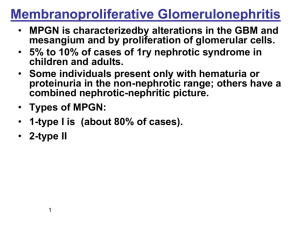Glomerulonephritis BPT 2012
advertisement
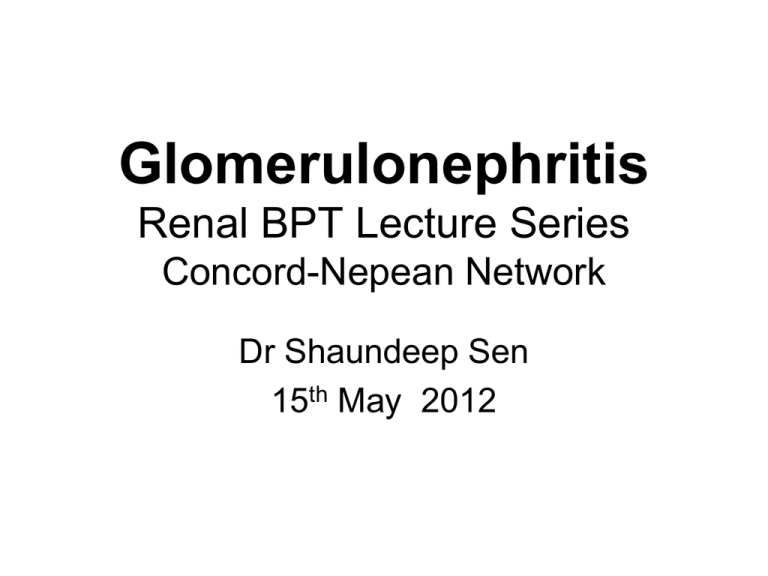
Glomerulonephritis Renal BPT Lecture Series Concord-Nepean Network Dr Shaundeep Sen 15th May 2012 Glomerulonephritis • • • • • • • Incidence Presentation Investigation Classification Pathophysiology Management Outcomes Incidence • Limited data on incidence or prevalence of disease – Definition/Investigation Issues • Rates of ~0.2-2.5/100,000 person years (McGrogan 2011 NDT) • 21% of those commencing KRT in 2010 in Australia had a diagnosis of GN (ANZDATA Report 2011) – ¼ were IgA mesangiocapillary GN **Biopsy Underutilised for Diagnosis** Classification? Over 50 Different Classification Systems • Histologic – Location/Aetiology of Damage • Clinical Presentation • Primary vs Secondary Harrison’s, Kumar, UpToDate Glomerular Disorders - Primary •IgA nephropathy •Acute proliferative glomerulonephritis –Post-infectious –Other •Rapidly progressive (crescentic) glomerulonephritis •Minimal-change disease •Focal segmental glomerulosclerosis •Membranous glomerulopathy •Membranoproliferative glomerulonephritis •Chronic glomerulonephritis Glomerular Disorders - Secondary •Systemic lupus erythematosus •Diabetes mellitus •Deposition Diseases – – Amyloidosis Light Chain Deposition Disease •Goodpasture syndrome •Microscopic polyarteritis/polyangiitis •Wegener granulomatosis •(Henoch-Schonlein purpura) •Bacterial endocarditis •Cryoglobulinaemia •Thrombotic microangiopathies •Malignancies: – – Hodgkin's lymphoma lung and colorectal cancer Glomerular Disorders - Hereditary • Alport Syndrome • Thin Basement Membrane Disorder • Fabry Disease Nephritic Syndrome • Manifestations: – Hematuria, azotemia, variable proteinuria, oliguria, edema, and hypertension • Conditions: – IgA nephropathy • Episodic, <5/7 post URTI – Postinfectious GN • Abrupt onset, 1-3/52 post-infection – Rapidly progressive GN • Vasculitis • Anti-GBM GN Nephrotic Syndrome • Manifestations: – >3.5 gm/day proteinuria, hypoalbuminemia (<30g/L), hyperlipidemia (with low HDL), lipiduria – Thrombo-embolic events (esp if Albumin <20g/L, with loss of anti-thrombin III and antiplasmins in urine) • Conditions: – – – – – Deposition diseases Minimal change disease Focal and segmental glomerulosclerosis Membranous nephropathy Membranoproliferative GN Rapidly Progressive GN • Manifestations: – Abrupt Onset, HT, haematuria, variable proteinuria • Conditions: – Type I (Anti-GBM Ab): • Renal-limited, Goodpasture’s – Type II (Immune Complex): • Idiopathic, IgA/HSP, PIGN, Other – Type III (Pauci-Immune): • ANCA, Idiopathic, Wegener’s, Microscopic Polyangiitis Aetiology • Autoimmune – – – – – Goodpasture’s IgA Lupus Hereditary nephritis – Alport’s Syndrome Membraneous GN • Infection-Related – PIGN – HIV – Infective Endocarditis • Sclerotic – MCD – FSGS – Diabetic Nephropathy Histologic Changes • Hypercellularity – – – Mesangial or Endothelial Cells Leucocytes Crescents • • • Basement Membrane Thickening – – – • Deposition immune complexes, amyloid, cryoglobulins, fibrin, fibrils Increased GBM production, eg DM Podocyte Changes Hyalinosis – • ?Fibrin, TNF-alpha, Tissue Factor, IFN-gamma Parietal epithelial cells and leukocytes infiltrate Homogenous, eosinophilic (LM), extracellular (EM), obliterates capillaries – end-pathology of disease, FSGS Sclerosis – – Accummulation extra-cellular collagenous matrix In mesangium only (DM), or capillaries also DIFFUSE vs FOCAL GLOBAL vs SEGMENTAL IgA Nephropathy • Most common GN diagnosed by Biopsy • Deposition of IgA1-IgA1 or IgA1-IgG complex in mesangium • Present ?>20% of general population on autopsy studies, majority with no evidence of renal disease • Variable presentation: – – – – Incidental finding on UA, HT (30%) Episodic with URTI (60%) RPGN / Nephritic / Nephrotic Association with CLD (poor clearance Abs) Antibodies IgA Nephropathy Clinical Risk Factors for Progression: • Proteinuria • Hypertension • Reduced eGFR at time of diagnosis • Elderly, male • DD genotype for ACE gene • Serum IgA level not diagnostic – Cf IgA1 level NOT macroscopic haematuria Prognosis: ESKD 20-40% @ 5-35 years IgA Nephropathy Oxford Histological Classification of IgA: • Mesangial cellularity score • %gloms with segmental adhesion or sclerosis • %gloms with endocapillary hypercellularity • % interstit fibrosis / tubular atrophy Associated with reduction in eGFR, proteinuria KI (2009). 76. 534-45, 546-56 IgA Nephropathy Primary Abnormality: •Galactose-deficient hinge region O-glycans IgA1 production IgA Nephropathy Controversial: Fish Oil – limited benefit Tonsillectomy Alcohol Anti-Platelet Therapy IgA Nephropathy Immunosuppression • eGFR > 50ml/min, proteinuria >1gm: – Corticosteroids 6 months • • • • • • • MMF – limited data Combination therapy – not recommended eGFR < 50ml/min – supportive therapy only RPGN – treat with combination therapy Nephrotic – oral corticosteroids 6 months Secondary IgA (Liver ) – supportive only Transplant Recurrence – supportive only Post-Infectious GN (1) • Decreasing incidence in the Western world • In children and the elderly with EtOH or IVDU • Due to Group A (or C) Strep infection (throat/skin), producing nephritogenic Ag’s that activate the alternate complement pathway, via plasmin: – Nephritis-associated plasmin receptor (NAPlr, glyceraldehyde-3phosphate dehydrogenase) • Present early in the mesangium in kidney biopsies – Streptococcal pyrogenic exotoxin B (SPEB) – a cationic cysteine proteinase generated by proteolysis of a zymogen precursor (zSPEB) • Present later in sub-epithelial humps (diagnostic) Rodriguez-Iturbe 2008 JASN Post-Infectious GN (2) • Presentation – Nephritic Syndrome 1-3 weeks post infection – Rust-coloured urine • ~10-20% Pharyngitis due to Strep – Clin risk factors: <14yoa, no cough, tender LNs, fever >38, tonsillar swelling or exudate • DDx – IgA (temporal) – TBMD – Hereditary Nephritis Post-Infectious GN (3) • Investigations: • Bloods – electrolytes, C3/C4 (↓ for up to 8 weeks only), Antistreptolysin O titre, AntiDNase B Ab • Urine – Micro, RBCs, Proteinuria • Renal Biopsy - diagnostic H+E of glom showing increased mesangium, PMNs, endocapillary prolif IgG and C3 on IF (IgG shown) irregularly lining the capillaries Epithelial “humps” (IgG, C3), can also get other less-organised deposits Post-Infectious GN (4) Management • Hypertension – in up to 75% of children – Aetiology unclear (Na/H2O retention) • Antibiotics – no renal benefit once immune activation occurred; TREAT EARLY Prognosis • Children – 1-2% CKD • Elderly – up to 50% CKD RPGN • Clinical and Histologic Diagnosis: – Rapid loss GFR over days to weeks with evidence glomerular disease (active urine) – Crescents on biopsy: RPGN Classification • Primary: – TYPE I: Anti-GBM Ab Disease – TYPE II: Granular Immune Complex Assoc (IgA, PIGN) – TYPE III: Pauci-Immune • Secondary: – – – – – – – Superimposed Post-infectious Vasculitic Polyarteritis nodosa Goodpasture’s Syndrome Carcinoma Allopurinol / Penicillamine Anti-GBM • Ab predominantly to NC1 domain of α3 chain of type IV collagen – Found in GBM and alveolar BM (+retina, choroid plexus) – Normally in hexamer with α4 and α5 • α3 only “available” if exposed after other insult, eg – exposure to hydrocarbons, smoking, infection, lithotripsy, degradation by reactive oxygen species or BM disruption due to other GN Anti-GBM • Ab is IgG1 > IgG3 • Also role for autoreactive T-Cells • HLA DRB1*1501 confers 3x RR (but present 30% caucasian population) NOTE: Alport’s recurrence in Kidney Transplants is due to formation of Ab to α5 chain, even if in hexamer Anti-GBM Investigations • Urine: active sediment • Serum: – EUC – C3 – pANCA/MPO: 30% dual +ve (relapse) – Anti-GBM Ab • Kidney Biopsy Anti-GBM: IgG and C3 deposition (IgG shown) in linear pattern along GBM Anti-GBM Treatment: If mild/moderate kidney failure • Pulse Prednisolone • Cyclophosphamide • Plasmapheresis/exchange • ?Rituximab If dialysis-dependent with poor Bx findings • Supportive Pauci-Immune GN • Chapel Hill Classification of Vasculitis based on size of vessel affected: • Large – Giant Cell Arteritis, Takayasu • Medium – Kawasaki Disease (nil renal), Polyarteritis Nodosa (may involve renal arteries) • Small – Wegener’s Granulomatosis (small arts and veins, GN + Pul) – Churg Strauss (EΦ) – Microscopic Polyangiitis (GN + pul capillaritis) – HSP (renal, skin gut) – Cryoglobulinaemic (Skin + GN) – Cutaneous leukocytoclastic (isolated to skin only) 80-90% Pauci Immune GN are ANCA Positive WG and MPA • Age 60-80yoa • Systemic symptoms over weeks – Fever, malaise, myalgia, arthralgia, weight loss • Renal involvement – oliguria, h’aturia, p’uria, RBC casts, rapid decline eGFR • Diffuse alveolar haemorrhage • Palpable purpuric skin lesions, esp LLs • WG: sinusitis, rhinitis, otitis, ocular inflammation Pauci-Immune GN Investigations: – Normal complement levels – WG: cANCA/PR3 +ve 80-95% – MPA: pANCA/MPO +ve 40-80% • Kidney Biopsy: • • • • • • Vasculitic changes in arterioles and venules Mesangio-prolif Segmental necrotising Crescents No IF staining EM: no deposits Pauci-Immune GN Negative Prognostic Markers: • Increased creatinine • African-American race • Arterial sclerosis NOT: pul disease, crescents/necrosis on Bx, age Pathogenesis unclear: ?cross-reactive Abs in response to fimbriated bacterial infection, against lysosomal membrane protein-3. LMP-3 colocalised to MPO and PR3 in vesicle… Pauci-Immune GN • Management – WG/MPA • Steroids – Pulsed if RPGN, pulmonary haemorrhage • Cyclophosphamide – ?advantage of iv over oral • Azathioprine – For maintenance • Rituximab (anti-CD20, B-cell depleting) – No benefit over cyclophos (NEJM 363;3, 211220) Pauci-Immune GN • • • • Prognosis WG/MPA: 70% get renal involvement 70-90% respond to Cyclophos Mx 1 year mortality 15% – Active infection – Vasculitis Podocyte Function & Disease Minimal Change Disease • 20-30% adults who present nephrotic • Normal light microscopy with podocyte foot effacement on EM • ?presence of as yet unidentified glomerular permeability factor • Role of T- and B-Cell dysfunction Minimal Change Disease • Primary vs • Secondary: – NSAIDs, COX Iii, Li, amp/rifamp/cephs, Dpenicillamine, pamidronate, sulfasalazine, trimethadione, immunisations, gamma-IFN – Malignancy (Hodgkin, NHL, leukaemia) – Infection (syphilis, TB, mycobact, HIV…) – Allergy – Other glom diseases (IgA, SLE, DM, PKD) Minimal Change Disease • Complications – VTE – T-Cell dysfunction leading to infection with encapsulated organisms: • S pneumoniae • E coli • H influenzae Minimal Change Disease • • • • • Treatment: Supportive – Na restrict, diuretics Steroids +/- cyclophosphamide/CyA Relapses common, resistance to pred common in younger age groups • Prognosis: • Good unless steroid resistant, then 3050% ESKD in 5 years Focal and Segmental Glomerulosclerosis • • • • • 40% of Nephrotic presentations Incidence 7 per million >50% of cases present nephrotic 80% idiopathic/primary Secondary causes: – Genetic: ?APOL1 G1 and G2 – Virus: HIV 1, Parvo B19, SV40, CMV, EBV – Drugs: heroin, IFN, Li, Pamidronate, mTORi, CNI – Adaptive: in response to reduced renal mass or inadequate mass 2+ hits to podocytes FSGS FSGS • • • • • • Worse Prognosis: African American Increased proteinuria Poor kidney function IF/TA, collapsing variant on Bx Partial or no remission on treatment • ?role soluble urokinase receptor 50% ESKD @ 10yrs if nephrotic range proteinturia 20-40% recurrence risk in KTx Membranous Nephropathy • 1 case per 100,000 person years • Most common adult diagnosis for nephrotic syndrome (increasing frequency with age for idiopathic form) • 80-95% >50yoa at diagnosis • Incidence male=female, but male worse outcome RR~3 • Primary/idiopathic vs secondary (~30%) Membranous Nephropathy Aetiology for Idiopathic MN: • Antigens: – Neutral endopeptidase in neonates whose mother is deficient – M-type phospholipase A2 receptor (PLA2R1) • Antibodies to: – Aldo-keto-reductase family 1, member 1 (AKR1B1) – Mitochondrial superoxide dismutase 2 (SOD2) • HLA-DQA1 allele on chromo 6p21 Membranous Nephropathy Secondary Causes: • Infections – HBV, HCV, Malaria, …. • Autoimmune – SLE, RA, Sarcoid…. • Malignancies – Lung, colon, breast, stomach, oesoph; melanoma; leukaemia; NHL • Meds – gold, D-penicillamine, Hg, captopril, probenecid, trimethadione, NSAIDs • Genetic – sickle cell, Fanconi’s, ?DM • Other MUST RULE THESE OUT Membranous Nephropathy • • • • Investigations: “Nephrosis” screen (50% also have h’aturia) Normal serum complement Renal Biopsy: – Grading I-IV of sub-epithelial “spike” deposits of IgG and C3 – Thickened GBM – IF/TA – EM: deposits with podocyte foot effacement and new GBM growth • Endothelial cell tubulo-reticular structures = Lupus • Mesangial deposits = HBV, Lupus Membranous Nephropathy Membranous Nephropathy Membranous Nephropathy Progression • 20-40% complete remission • 20-35% partial remission • 10-30% to ESKD over 10-20 years – Risk factors: • • • • • Male >10gm/24hr proteinuria HT Azotemia Tubulo-interstit fibrosis and glomerulosclerosis Membranous Nephropathy Management: • Supportive – – – – ACEi / ARB Lipids Diuretics ?anti-platelet/-coagulant • Immunosuppression – Moderate Risk (if prot > 4gm/24hr after 6/12) • Steroids + Cyclophosphamide • Steroids + CNI – High Risk (prot >8gm for >3/12, dec eGFR) • As above, but CNI ?first – Resistant – RITUXIMAB (if eGFR >75ml/min) Membranoproliferative GN • 3rd-4th most common primary GN cause of ESKD • Present any age, and any renal condition, ie rapid/chronic, nephritic (20%)/nephrotic (50%), RPGN, asyptomatic proteinuria (30%) • Primary (unknown aetiology ? Low C3 levels) vs Secondary • Diagnosis by biopsy MPGN • Three Types; all have classic Histo finding of mesangial expansion and thickening of glom capillary walls – Thickening due to immune and mesangial matrix deposits causing double contour of GBM (“tram tracks”) MPGN • Type I – immune complex – Bx: nodular sub-endothelial/mesangial deposits, with IgG/C3 – Serum: all complement components reduced (classical pathway activation) MPGN • Type II – Dense Deposit Disease – C3 deposits only, in ribbon-like fashion on GBM with nodular mesangial deposits – C3 only low in serum: ?alternative pathway MPGN • Type III – C3/IgG with mixed subendothelial “Tram tracks” and subepithelial “spikes” • Low C3 and C5, normal C4 MPGN • Secondary Causes: • Infection: HBV, HCV+cryo, IEndo, EBV, HIV… • Autoimmune: SLE, RA, SS, Sarcoid… • Chronic Liver Disease • Thombotic microangiopathy • Malignancy • Genetic • Dysproteinaemia MPGN Treatment: • Underlying disorders • General Supportive • ACEi • ?anti-platelet • Alte die glucocorticoids • ?eculizimab (anti-C5 mAb) Prognosis: • ? Up to 60% renal survival at 20 years Summary • Rare condition with potentially catastrophic consequences • Early diagnosis critical • Multiple classifications systems – Clinical presentation – Histologic – Pathogenic • Pathophysiology not known for all conditions • Supportive/General Measures for all Summary • Investigate for and treat underlying conditions • Judicious use of immunosuppressives – Natural history of the disease – Patient factors – ?salvageable renal tissue • More RCTs needed, cf anti-CD20 esp.
